Centennial Year Church Services
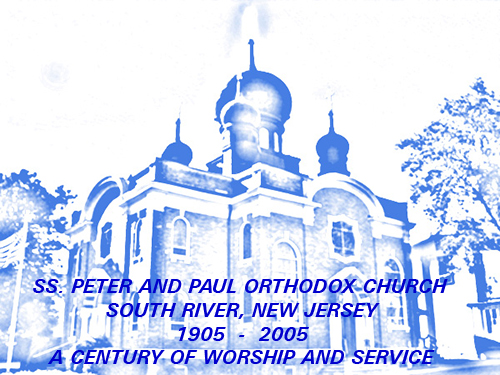 |
March 6, 2005 - The Celebration of Proskomedia - Early in the morning (8:15 a.m.) before Divine Liturgy proper, Rev. David Garretson celebrated the Office of Proskomedia not at the usual Table of Oblation (oblation - from the Latin meaning "to offer") in the Sanctuary where only the Altar servers can witness the service but rather at the Tetrapod in the center of SS. Peter and Paul Orthodox Church where all parishioners who arrived early could witness the service. The photoreport which follows is extensive and, for convenience, it is divided into three portions: (1) the Entrance Prayers for the clergy as they enter a temple and the vesting of clergy prior to serving the Proskomedia; (2) the Office of Proskomedia; and (3) the Great Entrance of the Divine Liturgy. In order to be painstakingly accurate with regard to the service itself, the following text which appears in quotation marks later in this report is taken verbatim from the book "The Law of God" (printed by the printshop of St. Job of Pochaev at Holy Trinity Monastery in Jordanville, N.Y.) by Archpriest Seraphim Slobodskoy. For the exact prayers of the Proskomedia service, the viewer is referred to the "Service Book of the Holy Orthodox-Catholic Apostolic Church" by Isabel Florence Hapgood.
The two photos above show the center Tetrapod in our Church as it appeared at 8:00 a.m. in the morning. In the block of eight photos below, Fr. David recites the Entrance Prayers and then vests before the Proskomedia. As he places on each piece of the priest's vestments - Cassock, Stole, Zone (Girdle), Cuffs, Thigh Shield, and, lastly, the Chasuble - in that order, Fr. David named each piece and discussed its symbolism.
In the block of six photos below, Fr. David washes his hands before the celebration of the Proskomedia with the assistance of Reader Joseph Shaluha. He also explains to the parishioners the Altar Bread and the significance of the sacred vessels and implements - the Paten (photo above), the Star-cover, the Chalice (photo above), the Spear (photo above), and the Spoon.
You may click on the photo above right to view an enlargement.
"In order to prepare, according to the ecclesiastical Typikon, for the celebration of the Liturgy, the priest and deacon read the "entrance prayers" before the closed doors of the Royal Doors and then enter the Sanctuary and vest. Then going to the Altar of Oblation the priest blesses the beginning of Prokomedia, takes the first prosphora, the Lamb, and with the spear makes the sign of the Cross over it three times, saying the words, "In remembrance of our Lord and God and Savior, Jesus Christ." These words mean that the Proskomedia is celebrated according to the commandments of Jesus Christ. The priest then cuts a cube out of the center of this prosphora with the spear and pronounces the words of the Prophet Isaiah, He was led as a sheep to the slaughter, and as a blameless lamb before his shearer is dumb, so He openeth not His mouth; in His lowliness His Judgement was taken away (Isaiah 53:7-8)."
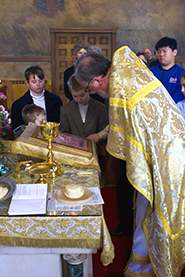 |
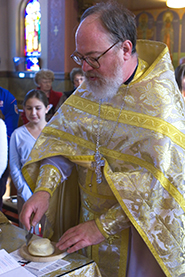 |
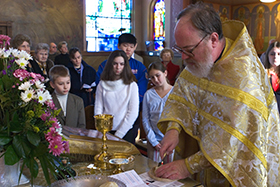 |
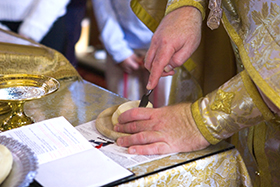 |
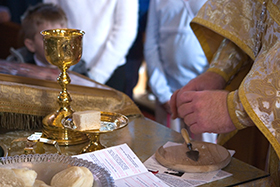 |
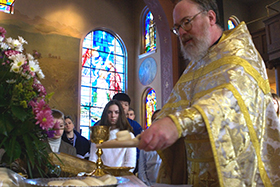 |
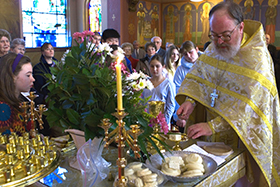 |
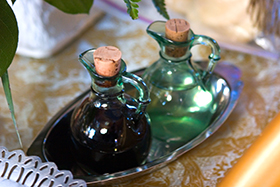 |
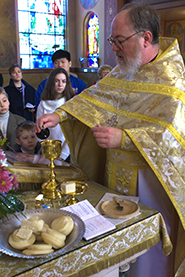 |
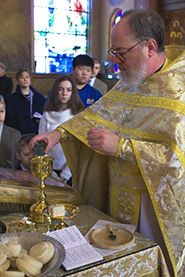 |
"This cubical portion of the prosphora is called the Lamb (John 1:29) and is placed on the diskos. Then the priest cuts cruciformly the lower side of the Lamb while saying the words, "Sacrificed is the Lamb of God, that taketh away the sins of the world, for the life and salvation of the world." He then pierces the right side of the Lamb with the spear, saying the words of the Evangelist, One of the soldiers with a spear pierced His side, and forthwith there came out blood and water. And he that saw it bare witness, and his witness is true (John 19:34). In accordance with these words wine is poured into the chalice mixed with water. From the second prosphora the priest cuts out one portion in honor of the Mother of God and places it on the right side of the Lamb on the diskos. From the third prosphora, which is called "that of the nine ranks", are taken nine portions in honor of the saints, John the Baptist, the prophets, the apostles,"
 |
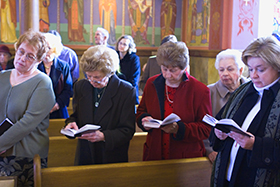 |
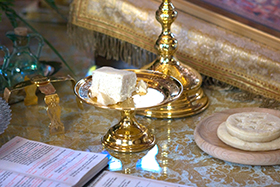 |
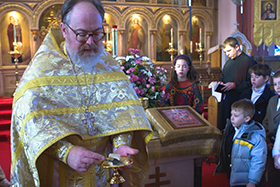 |
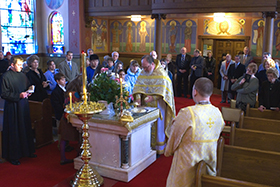 |
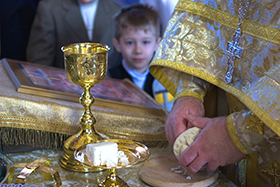 |
You may click on the photo above left to view an enlargement.
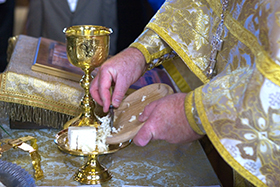 |
 |
 |
"the hierarchs, the martyrs, the monastic saints, the unmercenaries, the parents of God, Joachim and Anna, the saint who is celebrated that day, and finally the saint whose liturgy is being celebrated. These portions are placed on the left side of the Lamb on the diskos in three rows of three. From the fourth prosphora portions are removed for the hierarchs, the priesthood, and all the living, and are placed below the Lamb. From the fifth prosphora, portions are taken for those Orthodox Christians who have reposed, and these are placed just below those which were removed for the living. Finally, portions are removed from those prosphoras donated by the faithful as the names of the living and the dead are read simultaneously for the health and salvation and the repose of the servants of God. These are placed together with those portions taken from the fourth and fifth prosphoras. The Russian tradition is to use five separate prosphoras at the Proskomedia. Other traditions such as the Greek use one or two large ones from which the portions are taken."
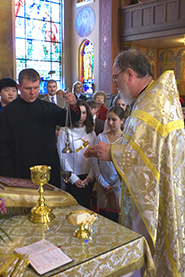 |
 |
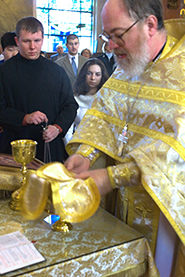 |
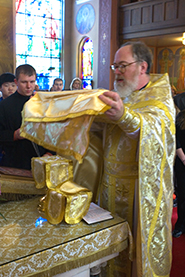 |
"At the end of the Proskomedia the priest blesses the censer and incense, and after censing the Star he places it on the diskos over the Lamb and the portions in order to preserve their arrangement. He covers the diskos and chalice with two small cruciform cloth covers, nd over the two of them another larger veil called the "aer" is placed. Then he censes the Holy Gifts and prays that the Lord bless the offered gifts, remember those who have offered them and those for whom they are offered, and make the priest himself worthy for the solemn performance of the Divine Mystery. The sacred instruments used and actions performed in the Proskomedia have a symbolic meaning. The Diskos signifies the cave in Bethlehem and Golgotha; the Star, the star of Bethlehem and the Cross; the Covers and Veils, the swaddling clothes and the winding sheet at the tomb of the Saviour; the Chalice, that cup in which Jesus Christ sanctified the wine; the prepared Lamb, the judgment, passion, and death of Jesus Christ; its piercing by the spear, the piercing of Christ's body by one of the soldiers."
"The arrangement of all the portions in a certain order on the diskos signifies the entire Kingdom of God whose members consist of the Mother of God, the angels, all the holy men who have been pleasing to God, all the faithful Orthodox Christians, living and dead, and in the center its head, the Lord Himself, our Saviour. The censing signifies the overshadowing by the Holy Spirit, whose Grace is shared in the Mystery of Holy Communion. The Proskomedia is performed by the priest in a quiet voice at the Table of Oblation when the Sanctuary is closed. During the celebration, the Third and Sixth (and sometimes the Ninth) Hours are read according to the Horologion."
In the photos immediately above and below, scenes from the Great Entrance of the Divine Liturgy. The Liturgy then proceeds to its conclusion in the typical manner.
You may click on the photo above left to view an enlarged image.
return to photos menu
return to homepage
Copyright © 2005, Saints Peter and Paul Orthodox Church, South River, NJ
